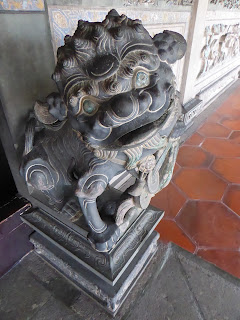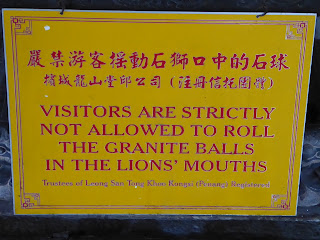Georgetown is the old British colonial capital and now a UNESCO World Heritage sight. The hotel I was staying in ran a shuttle bus into town, and that was one of the reasons I stayed there. And Georgetown has a reputation for good food.
Oh how disappointing was reality. Firstly, the last shuttle bus came home at 5;30, so effectively that put the end on the idea of dinner here without getting a taxi.
Secondly, most of the World Heritage area is just very run down. Its a "living area, so very much still used for business, partly the business of flogging souvenirs or food and drink to tourists. It was primarily built by Chinese colonists, coming to a freer way of life under British colonial rule than Chinese native rule. Although it also encompasses a Little India. Its quite cosmopolitan.
Now first thing to note about the Chinese influence here, and therefore the main tourist attractions, are the Clanhouses, ie big "houses" established for the Chinese clans that settled here. But so important was the religious element to these clans, that what one really sees are temples with accommodation attached. And I am afraid to the untrained eye (ie mine) they do rather look alike. Gaudy, attractive, but a little similar. So lets start at what I think is Teochew Temple on Armenian Street.
Almost the most interesting part was seeing the room with 50s/60s western furniture - TV, sewing- machine
The house below is derelict. It had already been restored once, but now needs a substantial overhaul. When the upper storey is propped up by wooden pit props, its not a good sign.
I went into the Sun Yat Sun Museum largely because the bloke inside almost hauled me in to his little museum. In all honesty it was no larger, and less interesting, than the downstairs of my house (pre burglary anyway) although admission was under a quid and you got tea (out of a Thermos) free. It was used by the nationalist leader Sun Yat Sun when in Penang fomenting revolution in his native land although all it really has tangibly to link to him are some photos and press cuttings on the walls. But is a nice enough example of a Malaysian house of the period with living room, open courtyard in the middle and kitchen to the rear.
I think this below is the Hock Teik Cheng Sin Temple on Cannon Street, although wouldn't swear to it
Now Armenian Street and the surrounds is well-known for its street art. Sort of poor man's Banksy. It is poor because they have got the stencilling but not the wit. Best is probably this stencil over a real bike. Mixed media.
The sign below relates to the lion above. You have to admit, its a very specific prohibition, well above the usual "Do Not Touch"
I thought the most fascinating rooms were those effectively acting as roles of honour, listing where various family members had been packed off to university.
The carved decoration is very impressive. A lot of man hours went into this.
I also loved the fierce carved Indian Guards
As I say, a mixed cosmopolitan area, with mosques too.
And churches. This is the rather nice St George's Church. A fine example of colonial architecture.
But just beyond are the shiny new buildings of the city. The area has rapidly developed so run down and impressively modern sit almost cheek by jowl.
Now top sitre is supposed to be the Blue Mansion, the Cheong Fatt Tze Mansion. Apparently this was considered one of the top ten mansions in the wrld, I think by Lonely Planet. Let ne tell you that on any logical scale, it wouldn't even make the top ten in any county in England. Might get in to a gfew of the more obscure counties in Wales.
That isn't to say it isn't pretty and interesting. But you can only enter on guided tours and to make this an hour's tour that means an awful lot of talking. You aren't looking at more than half a dozen rooms.
What it actually is now is a luxury hotel, with each wing containing 9 rooms and the middle as restaurant, museum and wedding venue.
Cenotaph.
Cornwallis Fort































































































No comments:
Post a Comment